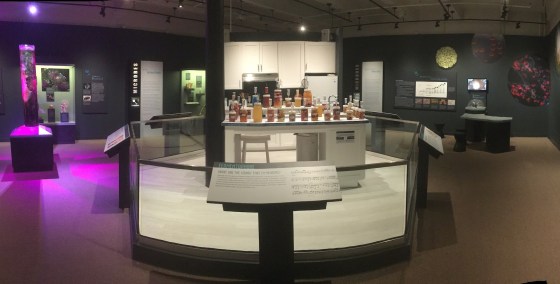Fermentophone was presented at the Harvard Museum of Natural History in the Microbial Life gallery in February 2020.
Fermentophone
This exhibit displays a musical instrument known as “Fermentophone.” The instrument is played by the activity of live microbes in fermenting foods and drinks. Each jar is a living work of food art that is bubbling with activity.

Who made Fermentophone?
Fermentophone was created by Joshua Pablo Rosenstock, an artist, musician, and foodie who lives in Somerville. This installation was created in collaboration with the Harvard Food Literacy Project Fellows, members and friends of the Somerville Community Growing Center, and students from Ms. Rodriguez’ 3rd grade class at Albert F. Argenziano School in Somerville who created most of the jars in fermentation art workshops leading up to the opening of the Fermentophone.
Microbes are playing the music? How does that work?
As microscopic bacteria and yeast eat the sugars in the raw ingredients, they produce carbon dioxide gas. This CO2 comes out in the form of bubbles. Look closely at the “airlocks” on top of the jars and you may see some bubbles emerging. Little underwater microphones in the jars pick up the tiny burp of each bubble. These sounds get sent to a computer, where they are translated into musical tones.
What are the sounds that I’m hearing?
Although all of the jars are at various stages of fermentation, only four at a time are live Fermentophone performers. Each one acts like a different member of the band – one plays a melody part, others play harmony, another provides the bass line. The computer applies a set of compositional rules that determine which notes should be played by a synthesizer, but the rhythms are directly generated by the microbes’ bubbles. The music is improvised based on a familiar song – can you tell which one?
Fermentophone is edible!
All of the ingredients in the Fermentophone exhibit are fully edible. In fact, many beloved foods and drinks are produced with the help of bacteria, such as pickles, sauerkraut, kimchi, yogurt, salami, chocolate, and coffee, or fungi, as in bread, beer, cheese, soy sauce, and wine. Fermented foods exist all over the world and since ancient times humans have used fermentation techniques to preserve foods, enhance their healthiness, and make them delicious. Many of the same microbes that help make fermented foods also live in and on our bodies as part of the human microbiome, a complex, symbiotic system which contributes to our health but is not yet fully understood.
About the Artist
Joshua Pablo Rosenstock’s work playfully explores the relationship of humans to the natural world, fusing ancient and cutting edge technologies.
“I’m interested in creating open-ended systems that produce serendipitous results. I like to start a creative process going and be surprised by what comes out at the end. I’ve found that working with live microorganisms is a wonderful way to create generative art and music that is organic but also otherworldly and utterly non-human. With Fermentophone, I hope to use music to increase museum visitors’ attunement to our normally-invisible microscopic partners.”












